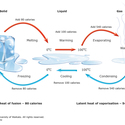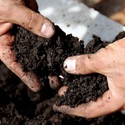All soils contain mineral1 particles, organic matter2, water and air. The combinations of these determine the soil’s properties – its texture, structure, porosity, chemistry and colour.
Soil texture
Soil is made up of different-sized particles. Soil texture3 refers to the size of the particles that make up the soil and depends on the proportion of sand, silt4 and clay-sized particles and organic5 matter6 in the soil. Sandy soils feel gritty when rubbed between your fingers. Silts feel smooth – a little like flour. Most clays are sticky and mouldable. If you’ve ever used pottery clay7, you’ll know the feeling.
Soils are made up of different combinations of sand, silt and clay particles. Soils that are a mixture of sand, silt and clay are called loams. The name of the soil often identifies the dominant8 particle9, for example, Timaru silt loam describes a soil that has a predominance of silt. Other examples of New Zealand soils are Waikare clay and Te Kopuru sand.
Soil texture can influence whether soils are free draining, whether they hold water and how easy it is for plant roots to grow.
- Sand particles are quite big. The pore spaces between the particles in sandy soils are also quite large. This allows water to drain quickly and air to enter the soil. Sandy soils tend not to get waterlogged in winter but can be subject to drought during summer.
- Silt particles are too small for us to see with our eyes. Silt soils have much smaller pore spaces but a lot more of them.
- Clay particles are smaller than 0.002 mm in diameter. Clay soils are poorly drained and hold on to the water in their pore spaces for much longer. However, they can become very hard if they dry out.
Soil structure
Soil structure10 describes the way the sand, silt and clay particles are clumped together. Organic matter (decaying plants and animals) and soil organisms like earthworms and bacteria11 influence soil structure. Clays, organic matter and materials excreted by soil organisms bind the soil particles together to form aggregates12. Soil structure is important for plant growth, regulating the movement of air and water, influencing root development and affecting nutrient13 availability. Good quality soils are friable (crumbly) and have fine aggregates so the soil breaks up easily if you squeeze it. Poor soil structure has coarse, very firm clods or no structure at all.
Soil porosity
Soil porosity14 refers to the pores within the soil. Porosity influences the movement of air and water. Healthy soils have many pores between and within the aggregates. Poor quality soils have few visible pores, cracks or holes. The way in which a soil is managed can affect its porosity. For example, look at areas around your school where students regularly walk. If the grass is worn away and the soil is exposed, it often looks different because it has been compacted and has had its structure and porosity altered. These are also areas where puddles form because the water is not able to drain away.
Soil chemistry
Clays and organic matter in the soil carry negative charges. Water in the soil dissolves nutrients15 and other chemicals16. Nutrients like potassium and ammonium17 have positive charges. They are attracted to the negatively charged organic and mineral matter, and this prevents them from being lost through leaching18 as water moves through the soil. Nitrate19 has a negative charge so it is not protected from leaching in most soils.
Soils can be acid20, alkaline21 or neutral. Soil pH22 influences nutrient absorption and plant growth. Some plants, like kūmara and potatoes, grow best in a more acidic soil (pH of 5.0–6.0). Carrots and lettuces prefer soils with a neutral pH of 7.0. Soils can become more acidic over time as minerals are leached23 away. Lime24 is often added to soil to make it less acidic. New Zealand paddocks are regularly limed to improve pasture growth.
Soil colour
If you thought that all soils are brown, think again. Soil colours range from black to red to white. Sometimes it can even be blue! Soil colour mostly comes from organic matter and iron25. Topsoil is often dark because of organic matter. An even, single colour indicates the soil is well drained. In contrast, rusty spots and grey patches (sometimes even a light blue in colour) indicate poor drainage.
Related activity
In this activity, students conduct a visual soil assessment to examine soil structure and look for earthworms.
Nature of science
To communicate in science, we need to use correct terms, vocabulary and conventions. One of the conventions involves the use of ancient Greek or Latin words to develop new terms. For example, pedology is the scientific study of soils. The name comes from two Greek words – ‘pedon’ meaning soil and ‘logos’ meaning study.
Useful links
Soil texture influences how water moves through soil. Listen as soil scientist26 Sam Carrick discusses a novel27 way to study water and animal urine movement in Canterbury's stony soils in this RNZ interview.
- mineral: 1. (Geology) A naturally occurring solid formed through geological processes. Any given mineral has a characteristic chemical composition and a specific set of physical properties. 2. (Dietary) An inorganic compound needed for proper body function and maintenance of health, for example, iron in the form of haeme present in red meat.
- organic matter: The decomposed remains of living organisms and their waste products.
- soil texture: The relative proportion of the various sizes of sand, silt and clay particles that make up a soil.
- silt: A granular material of a size somewhere between sand and clay. Its mineral origin is quartz and feldspar. Silt may occur as a soil or as suspended sediment in water. It may also exist at the bottom of a water body.
- organic: 1. Molecules that contain carbon and that have a biological origin. 2. Grown using natural processes with nutrients from natural sources.
- matter: The basic structural component of all things that have mass and volume.
- clay: A naturally occurring fine-grained material formed from the chemical weathering of feldspar minerals found in rocks.
- dominant: An allele that is expressed if it is present.
- particle: A tiny piece of matter. A particle may refer to an atom, part of an atom, a molecule or an ion.
- soil structure: The way that soil particles are arranged together.
- bacteria: (Singular: bacterium) Single-celled microorganisms that have no nucleus.
- aggregate: A collection of items gathered together to form a total quantity, for example, soil clumps together to form aggregates. Small aggregates can clump together to form larger aggregates called peds.
- nutrient: A substance that provides nourishment for growth or metabolism.
- soil porosity: Refers to the open spaces in soil between mineral particles or organic matter. Water or air usually occupies these spaces.
- nutrient: A substance that provides nourishment for growth or metabolism.
- chemicals: Everything is made up of chemicals. All matter (anything made of atoms) can be called chemicals. They can be in any form – liquid, solid or gas. Chemicals can be a pure substance or a mixture.
- ammonium: NH4+. Derived from ammonia by combination with a hydrogen ion. A nitrogen compound taken up by plants from soils.
- leaching: When a compound becomes dissolved in water and moves from one place to another, for example, a fertiliser in the soil dissolves in rain water and ends up in a stream.
- nitrate: A chemical composed of three oxygen atoms for every nitrogen atom.
- acid: A hydrogen-containing substance that is capable of donating a hydrogen ion to another substance.
- alkaline: A solution that has a pH value greater than 7.
- pH: A measure of the acidity or alkalinity of a substance, based on a scale of 0 to 14. Acidic solutions have pH values less than 7, whereas alkaline solutions have pH values greater than 7.
- leaching: When a compound becomes dissolved in water and moves from one place to another, for example, a fertiliser in the soil dissolves in rain water and ends up in a stream.
- lime: Chemically, lime is the compound calcium oxide. Commercially, lime could refer to ground-up calcium carbonate marketed as AgLime.
- iron: A chemical element with the symbol Fe.
- soil scientist: A scientist who studies soil, looking at a variety of aspects from the chemistry and form of soil to environmental protection and resource planning.
- novel: New or unusual in an interesting way.





